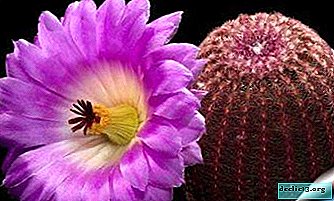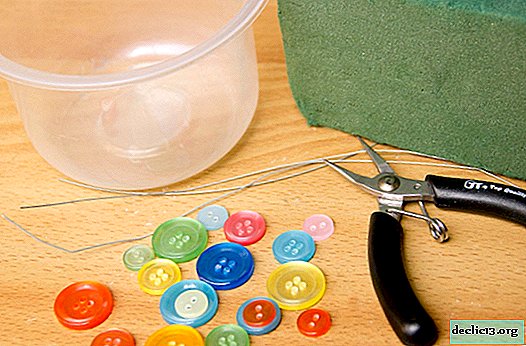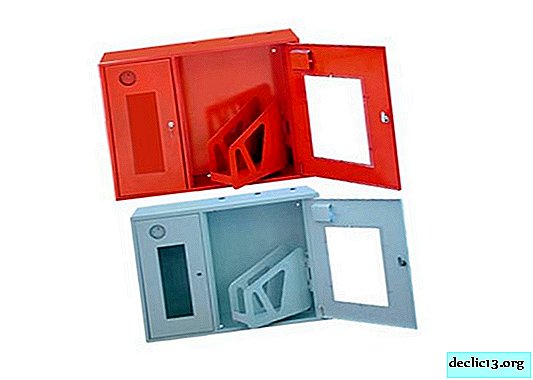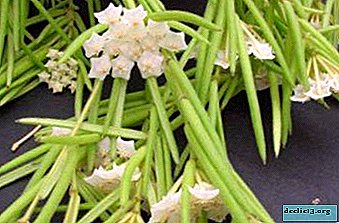Cactus with bright flowers - Echinocereus. Everything you need to know about this handsome

For more than five hundred years, flower growers have been growing cacti as indoor plants. In total, the Cactus family includes more than 120 genera. One of them is Echinocereus.
In our article, we will consider the main form of this succulent, we will talk about the rules of growing and caring for it. You will learn about the methods of breeding Echinocereus. You can also watch a useful video on this topic.
Botanical Description
The genus Echinocereus has about 70 species. Depending on the type of shoot can be round or cylindrical. The height does not exceed 60 cm, the average height is about 20 cm. The stems are highly branched - in older specimens, the number of shoots can reach hundreds.
Areoles - tubercles from which thorns grow are rarely located. The flowers are quite large - with a length of 2 to 6 cm and a diameter of 6-9 cm (in some species up to 12 cm). In shape, they resemble a funnel. Coloring is the most diverse - from bright scarlet to faded yellow-green. Fruits are small (1-3.5 cm in diameter), round, green or red. Buds and flower tubes are covered with thorns.
The main feature that distinguishes echinocereuses from other types of cacti is thorns on the fruits.. For this, the genus got its name from the Greek "echinos" - "hedgehog" and the Latin "cereus" - "candle". And at home, the plant is called a "strawberry cactus" or "strawberry hedgehog" for the excellent taste and aroma of the fruit. In nature, echinocereuses are found in North America in the southern United States and in Mexico, in sunny places - in deserts, prairies, on mountain slopes.
Read more about the botanical description and species of echinocereus here.
The main types and varieties of Echinocereus, their photo
Three-thorns

It differs in large scarlet flowers, a bit like poppies. In young plants, shoots are spherical, they are elongated with age.
Gingerless

The flowers of Echinocereus beskolyuchkovy resemble, rather, a yellowish daisy. The stems are cylindrical, with distinct deep ribs.
We wrote about cacti that have no thorns here.
Knippel

A bit like chamomile and flowers of Echinocereus Knippel, but their color is pale pink. Like the three-throated Echinocereus, the spherical stem of the young shoot takes the form of a cylinder as it grows older.
Hardest

Echinocereus the firmest looks very impressive thanks to large bright pink flowers. The color of the thorns depends on the lighting - in the shade they turn yellow, and in the sun they become pinkish. Plants with red spines are also found (Rubrispinus form).
Reichenbach

Echinocereus Reichenbach blooms with huge flowers (up to 10 cm in diameter, and up to 12 cm in the variety "Baileyi"), whose color varies from pink to purple (for different cacti blooming pink or having such a stalk color, read here). The stems are also cylindrical, form numerous shoots.
Home Care
Attention: Like most cacti, echinocereuses are quite unpretentious. If you follow simple rules, the flower will feel good for many years.- Lighting. You need to choose the sunniest window sill in the house, so that the rays of the sun fall directly on the plant. If the summer is hot, then it is advisable to take the cactus pot out into the fresh air.
- Watering. Excess moisture is unacceptable - it can lead to rotting of the roots. In winter, watering is not required, in the summer you need to water the flower abundantly, but before each watering you need to make sure that the soil is completely dry.
- Temperature. Like most cacti, echinocereuses, natives of the desert, are very thermophilic (read about cacti that grow in the desert here). In summer, it is desirable to provide a temperature of about + 30 ° C. In winter, the temperature should be maintained at about + 15 ° C. Nothing terrible will happen if the temperature drops a little lower. In nature, some echinocereuses even tolerate negative temperatures (up to -25 ° C). However, it is not worth experimenting. Echinocereus ringless can die at a temperature of + 5 ° C.
- Priming. In nature, echinocereus grows on stony and sandy soils, so ¼ coarse river sand and ¼ fine gravel should be added to the finished mixture for succulents purchased in the store.
- Pot. Since echinocereuses form many shoots, you need to choose fairly wide pots for them. The depth of the pot should not be large. The advantage of clay pots is their high ability to evaporate moisture, which prevents stagnation of water and rotting of roots. It is allowed to use plastic pots, but they do not allow moisture to pass through, so in this case you should choose the widest pot with a large evaporation area and take care of the drainage.
 Pruning. Cactus pruning is performed before transplantation if its lower part is affected. With a sharp knife, cut the affected tissue diagonally. After one and a half to two weeks, when the wound heals, you can plant the cactus in a new pot. Sometimes, if the cactus is very stretched, you can trim the top and sprinkle the wound with charcoal. Soon, a daughter shoot forms near the cut. It is better to perform this procedure in the spring.
Pruning. Cactus pruning is performed before transplantation if its lower part is affected. With a sharp knife, cut the affected tissue diagonally. After one and a half to two weeks, when the wound heals, you can plant the cactus in a new pot. Sometimes, if the cactus is very stretched, you can trim the top and sprinkle the wound with charcoal. Soon, a daughter shoot forms near the cut. It is better to perform this procedure in the spring.- Top dressing. Usually, echinocereus feels rather well without top dressing, but subject to regular transplantation. In the warm season, echinocereuses can be fertilized monthly with top dressing for succulents. In the period from autumn to spring, top dressing is not required.
Why do I need a transplant after winter?
The transplant is performed in the spring. Young, actively growing cacti need it annually, old - every 3-4 years. First you need to choose a pot, which should be slightly larger than the previous one, and prepare the soil, as described above.
To provide drainage, expanded clay or broken ceramics (brick, shards) is poured into the bottom of the pot. You can add chopped bottle cork and eggshell. Old drainage must be discarded. Then the cactus is carefully removed from the pot and the horse system is inspected. Rotten and dead roots are removed, and healthy roots are shortened by approximately 1/3. Soil in a new pot is slightly moistened and the plant is transplanted into it.
Important: Within 1-2 weeks after transplantation, echinocereus is not watered! Then for irrigation use the settled water at room temperature.We recommend watching the video about Echinocereus transplant:
Cultivation and reproduction
From seed
Growing a cactus from a seed is a rather laborious process.. Some gardeners manage to get the seeds on their own. For this, it is necessary to achieve the simultaneous flowering of two heterosexual echinocereuses belonging to the same species. A female flower is pollinated with a brush, and after ripening, its berries are broken and seeds are removed.
It is much easier to purchase ready-made seeds. Before sowing, they need to be soaked in a 3% hydrogen peroxide solution and incubated for five minutes. The soil and drainage are prepared in the same way as for transplanting cacti. Before sowing, the substrate is calcined. The smaller the size of the seed, the smaller the depth of sowing, and the smallest seeds are planted superficially.
 Greenhouse conditions with high humidity are necessary for seed germination. In the summer months, you can use the country greenhouse. Daytime temperature can reach + 40 ° С, at night it needs to be reduced to 20 ° С or even to 18 ° С. Germination of seeds can stretch for a long time. If some of the seeds have already sprouted and the rest are not, you can collect the seeds that have not sprouted and keep them in the vegetable compartment of the refrigerator for 3-4 months.
Greenhouse conditions with high humidity are necessary for seed germination. In the summer months, you can use the country greenhouse. Daytime temperature can reach + 40 ° С, at night it needs to be reduced to 20 ° С or even to 18 ° С. Germination of seeds can stretch for a long time. If some of the seeds have already sprouted and the rest are not, you can collect the seeds that have not sprouted and keep them in the vegetable compartment of the refrigerator for 3-4 months.
Most likely, with repeated sowing, they will quickly rise. When the seedlings grow a little, they need to be dived and transplanted either in small pots, or in one wide pot, in which there is enough space for everyone. The first two years of the life of echinocereus high temperature must be maintained throughout the year.
As with other plants, varietal traits may disappear during seed propagation.
We recommend watching a video about growing Echinocereus from seeds:
Lateral processes
An easier way to propagate echinocereus (as well as other cacti) - lateral processes. They often form at the bottom of the plant. It is necessary to select large processes (small can die before rooting), to separate them from the parent plant. If the process is separated with a knife, then it is necessary to process the cut with a solution of potassium permanganate.
You can also wait until the shoot itself is separated from the adult cactus. The shoots are laid out on a clean sheet of paper and dried in a well-ventilated area for several days until dry corn forms at the cut site. Sometimes it may take two weeks to heal a wound. Self-separated shoots do not need to be dried.
Next, a small pot is selected, soil and drainage are prepared, as for a transplant. The substrate must be wet.. The cut should be in contact with the ground, and the process does not need to be dug. The soil can be sprinkled with small stones - they will prevent the evaporation of moisture. After rooting the shoot, it must be looked after as an adult plant.
Bloom
Echinocereus can bloom in the third year of life. Buds appear next to the areola (in other cacti, flowers appear directly from the areola). First, small tubercles form near last year's areoles, usually on the shady side of the plant. This occurs in late winter - early spring.
During this period, you can not turn the cactus on the other side to the light, this can ruin the buds. The tissue of the stem is torn, the fluff is first shown, then the thorns. After this, the bud begins to grow, which can take up to two months. Before flowering, the tip of the bud is painted in a color characteristic of this type of echinocereus. Blooming flowers exude a pleasant citrus aroma.
Echinocereus blooms longer than other cacti, the flower can hold for a week.
We recommend watching a video about the features of flowering of Echinocereus:
Diseases and Pests
 The main problem that the grower may encounter is the decay of the roots of Echinocereus as a result of stagnation of water in the pot or high humidity. Compliance with the rules of the cactus will prevent this nuisance.
The main problem that the grower may encounter is the decay of the roots of Echinocereus as a result of stagnation of water in the pot or high humidity. Compliance with the rules of the cactus will prevent this nuisance.
Sometimes a flower can become a victim of pests such as mealybug, spider mite or shield aphid.
To destroy parasites, the plant is sprayed and watered with special means, and after the death of pests, they are transplanted into a new pot. The spider mite is manually removed and the cactus is treated with insecticides that kill the mite along with the larvae.
Similar plants
- Mamillaria - also a small spherical cactus with large white or red flowers (cacti that bloom in red are described here). A distinctive feature - the stem does not have ribs.
- Echinopsis - The most common cactus in indoor floriculture. As with echinocereus, the rounded stem elongates over time. His flowers are also large, ranging in color from white to purple.
- Notocactus - the shape of the stem is also close to echinocereus, the flowers are large, yellow, orange or red, on the flower tube, like the echinocereus, there are thorns (you can find out about the types of notocactus in this material).
- Echinocactus - A large spherical cactus with yellow, pink or red flowers. At home (in Mexico), candied fruits are made from its pulp.
- Astrophytum - a small cactus with a spherical or cylindrical stem, covered with white villi. The flowers are yellow, large
Conclusion
Echinocereus is easy enough to grow at home. With good care, they can bloom every year. Having collected a collection of different types of this elegant cactus on the windowsill, you can enjoy bright fragrant flowers for many years, and if you are lucky, then the fruits of the "strawberry hedgehog".

 Pruning. Cactus pruning is performed before transplantation if its lower part is affected. With a sharp knife, cut the affected tissue diagonally. After one and a half to two weeks, when the wound heals, you can plant the cactus in a new pot. Sometimes, if the cactus is very stretched, you can trim the top and sprinkle the wound with charcoal. Soon, a daughter shoot forms near the cut. It is better to perform this procedure in the spring.
Pruning. Cactus pruning is performed before transplantation if its lower part is affected. With a sharp knife, cut the affected tissue diagonally. After one and a half to two weeks, when the wound heals, you can plant the cactus in a new pot. Sometimes, if the cactus is very stretched, you can trim the top and sprinkle the wound with charcoal. Soon, a daughter shoot forms near the cut. It is better to perform this procedure in the spring.















